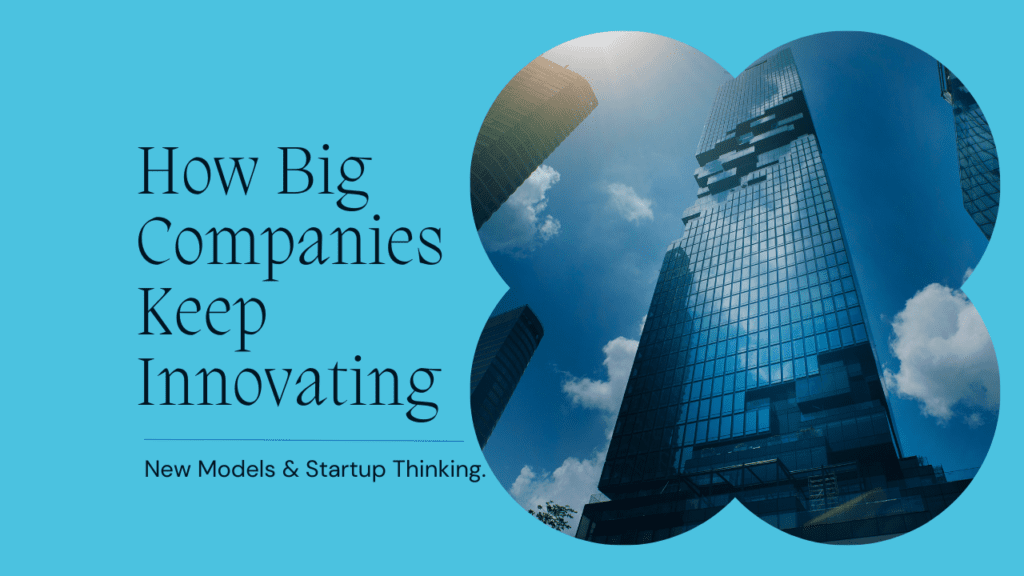How Big Companies Keep Innovating – New Models & Startup Thinking

Innovating today’s hyper-competitive business environment, companies can’t afford to rest on laurels or ossify around legacy processes. Continuous innovation is imperative to stay relevant with customers who have unlimited marketplace options. Yet fostering ongoing creativity presents a challenge for large corporate entities.
Most big firms recognize advancing tech trends and emerging consumer expectations and demand a commitment to perpetual product and business model reinvention. But fostering startup energy requires more than bolting digital transformation or innovation buzzwords onto HR pep talks or executive committee charter docs that then get buried in bureaucracy.
True innovation capacity can’t be achieved through a top-down decree. It gets nurtured through leadership priorities and cultural habits that empower employees closest to the problems to enact solutions. Promising movements are emerging around structured entrepreneurship, leveraged partnership models, and Lean methods to spark new thinking and products across the enterprise.
Startup Disciplines Taking Root Internally
Innovation notoriously faces inertia in big corporations where risk avoidance and established revenue streams breed complacency. However many companies are discovering startup disciplines help catalyze innovation initiatives internally:
Intrapreneurship Programs
Offering carefully scoped programs channeling startup ethos – like employee business plan competitions, incubators/accelerators, and commercialization funding pools – incentivizes ambitious teams to develop novel concepts and create MVPs. Democratizing access to resources lets dedicated staff self-select to pursue passion projects with support versus waiting for rigid timelines or permission from on high.
Platform enterprise Airbnb facilitates multiple internal incubators encouraging autonomous small team formation and problem finding. GoDaddy and Mastercard also foster intrapreneurship by running multi-month incubators helping employee-led startups conceive and prototype ventures leveraging corporate assets from brand reach to data resources. Participants gain dedicated time away from routine responsibilities with access to startup advisor mentors and modest seed funding upon completion.
Innovating Outposts
Positioning innovation labs or satellite offices in startup hotbeds immerses both visiting employees and locally recruited program managers in fertile entrepreneurial ecosystems. When PayPal wanted to expand offerings beyond core payment services they launched an Incubation Center in the Bay Area. Rotating in internal project leaders to immerse in the startup scene accelerated PayPal’s development of adjacent fintech products like Venmo.
Attracting outside entrepreneurial talent as dedicated innovation scouts offers another avenue to inject startup DNA. Big automaker GM’s innovation hub in Silicon Valley incubates employee ventures but also acquires experimental startups and shares knowledge across entities. Their investment arm keeps tabs on emerging tech like EV & mobility for future ventures.
Buying Sprouts Versus Just Harvests
Beyond internal cultivation programs, large companies hunt acquisition targets as both revenue infusions and innovation cell grafts. Historically big players focused M&A efforts gobbling up major platforms offering juicy monetization prospects – witness Microsoft absorbing established communities like GitHub, LinkedIn, and Activision Blizzard to expand ecosystem stickiness.
However buying pricey, polished platforms often locks in advantage vs catalyzing new leaps. The high premium drains budgets from further deals. And integration challenges swamp agile startup culture. Mastering “incorporate and smother” defeats the point.
Increasingly corporation development teams track seed stage ventures to snatch up before product-market traction emerges. The risks and costs seem like peanuts given the massive resources to accelerate sprouts once aboard. Tech titans Google, Meta, and Amazon actively troll early-stage verticals from AI to automotive and cloud infrastructure for acqui-hires that populate internal divisions growing platforms aligned with roadmaps. Global bank JPMChase similarly picked up portfolio budgeting app MC Budget for market entry acceleration into consumer planning.
The get-them-early approach pays off not just for immediate services gained but also for relationships with founders and teams with hands-on intimacy in bleeding-edge domains who stick around to advance the mothership.
Rapid Experiment Cycles – Like a Startup
Beyond buying startups’ exponential hockey stick growth, enterprises must adopt startup practices internally to keep innovating. This mandates leadership supporting lightweight development models.
Big players increasingly sanction experimental sprints using Agile software methods – what startups call Lean. Instead of rigid requirements and long launch timelines, empower small squads to rapidly build product minimum viable products (MVP) directly addressing observed consumer pain points, test with real users, iterate based on feedback, and prove market fit before scaling. Fail fast, learn quicker.
The MVP sprint mentality forces product managers and engineers to avoid overbuilding features nobody wants. Let real user pain drive design. Release beta services under live fire to uncover needs and frictions missed in conference rooms. Pivot fast.
Old school connotations of quality as hand-crafted perfection and polish slow innovation. Done beats perfectly to accelerate learning. Google ran “experiments of experiments” in its 20% culture encouraging product managers and engineers to trial endless ideas and capacity experiments on live infrastructure. Most failed as expected but enough struck gold like GMail and Google X moonshots to justify the waste.
While startups live or die through speed to product-market fit, legacy revenue means big corporations face a less existential threat from failed tests. But the urge to coast on strengths or avoid risks must be superseded by hunger which flows from leadership incentives downwards and across.
Of course, all the ideation, incubation mechanics, and Agile practices mean nothing without aligned cultures that celebrate failure as tuition and leaders judging experiments as passionately as profit centers. But frameworks channeling startup energies across big company arteries fertilize the future.
Read More:

